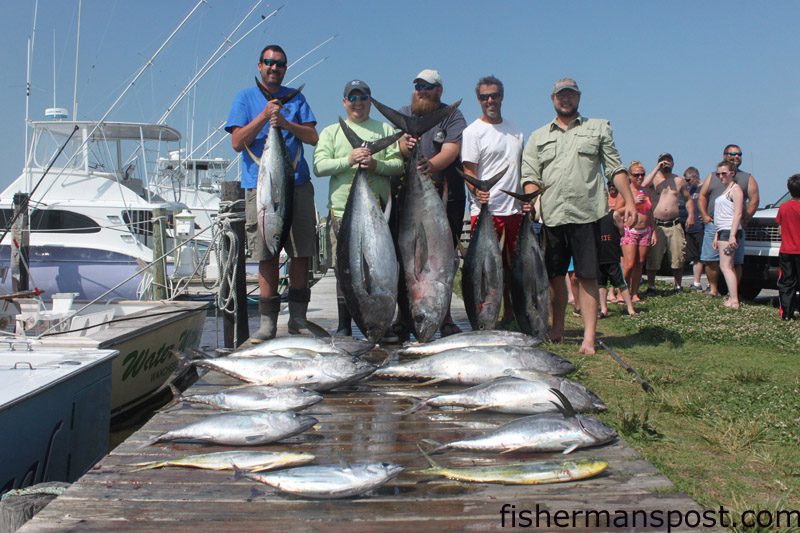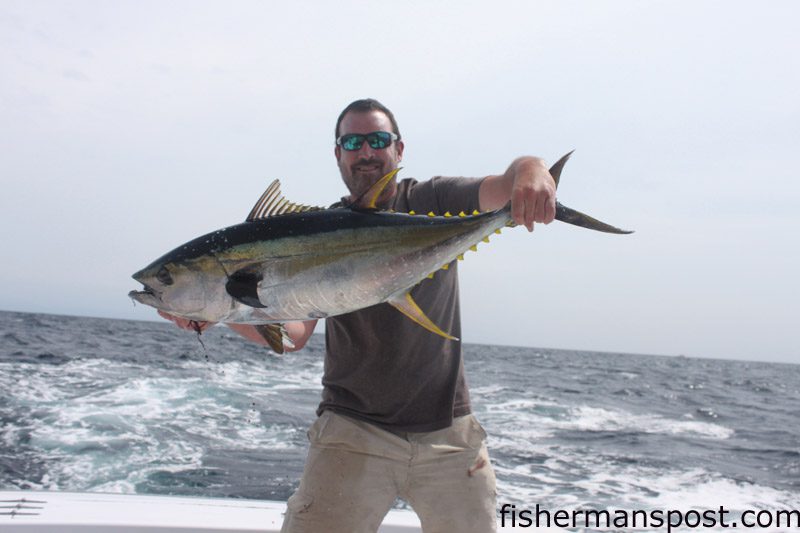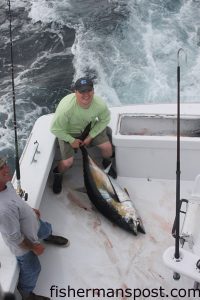Guide Time – Blood, Sweat, Tuna

Max Gaspeny, Chris Saunders, Joshua Alexander, Gary Hurley, and Eric Ramstrum with the bounty of a tuna fishing trip with mate Jason Sadler and Capt. David Peck aboard the “Skiligal” out of the Oregon Inlet Fishing Center–over 600 lbs. of bigeye and yellowfin tuna in total.
“That might be him, Jason,” Capt. David Peck said from the bridge of the charterboat “Skiligal” as he nudged the boat into gear for a quick turn to keep the unseen fish off the transom. Jason Sadler, manning the cockpit of the 53’ BC sportfishermen, muttered an assent while clearing a flatline to make room for what would likely turn into a lengthy battle if the captain’s prediction proved correct.
On this particular day “him” was a bigeye tuna, an elusive target at any time, let alone when a crew of newspapermen clamber aboard with the intent of putting together a story.
Though it was early yet and nowhere near the warmest day of the season, beads of sweat appeared on Joshua Alexander’s forehead as the Fisherman’s Post Sales Manager struggled to put line back onto the 50 Wide trolling outfit he was straddling in the fighting chair. The tussle had reached a stalemate after the reel’s spool narrowed considerably on the adversary’s first run, with the fish heading out and down, a strong indicator of a tuna bite.
The great populations of yellowfin tuna that school off Oregon Inlet have led to a legendary fishery for the local charter fleet, and we’d already introduced a few stout yellowfins to the transom fish box when Josh’s fish bit. Their larger Atlantic cousins, bigeyes are stronger and much less common, but the amount of 80 lb. monofilament this fish had dumped off the 50 dwarfed the runs of our yellowfins, adding credence to Jason and David’s hunch.
This trip had been over six months in the making, as I’ve always wanted to see a bigeye and had asked David in mid-December what dates he thought might produce our best odds.
“They’re ghosts any time of the year, but the week leading up to the full moon in June is about as good a time as you can pick,” was his reply.
A half-year later, Joshua, Fisherman’s Post Publisher Gary Hurley, myself, and friends/guest photographers Chris Saunders and Eric Ramstrum met up with David and Jason at the boat’s slip in Oregon Inlet Fishing Center well before dawn.
“The bite’s been early lately, so we should be heading out by 4:50,” David had explained during our drive up the previous afternoon.
We were treated to a much calmer than anticipated sea on our ride southeast of the inlet, a striking white moon illuminating our path and a dozen or so other boats who’d gotten an early start on the ride offshore.
Jason spent the last few minutes of the ride rigging ballyhoo behind sea witch skirts (and as I later found out, so had Dave, who keeps a personal bait cooler on the bridge), and the pair had a 10-line spread in the water moments after the captain throttled down to trolling speed. Most of the fleet was a bit to the south of us, around the hallowed tuna ground known as The Point (not to be confused with Cape Point, hallowed ground for Outer Banks surf casters and red drum), but Dave set the spread out a bit to the north of the crowd in hopes of finding some fish with a few less baits to look at.
Along with several instructions on what to do upon hookup, Jason had told us to keep our eyes peeled and not be shy about shouting out any working birds or fish activity we spotted.
“Bonitos, cap!” he shouted seconds later, his outstretched finger giving us a visual cue of what to look for a few hundred feet off the boat’s port bow.

The author with a healthy yellowfin tuna taken just north of The Point while fishing with Capt. Dave Peck on the “Skiligal.” A ballyhoo under a crystal sea witch fooled the yellowfin.
Dave angled the boat towards a few wheeling seabirds above some football-sized skipjack tunas (Nerf football at least) breaking water as they fed. The activity dispersed as the boat approached, but the move didn’t go unrewarded. The sound of an outrigger clip popping made my head swivel upward and Dave was soon passing a rod that strained as it surrendered line to an angry fish down from the bridge.
As the tallest person in the crew (and by design the most conveniently located at the moment), I took the trolling outfit from David as the fish continued ripping line from the reel, apparently realizing that its breakfast came with some consequences.
“Those aren’t really stand-up rods, but you can fight him standing if you want,” Jason explained while offering me a Cush-It, a foam device that pads the metal gimbal on a rod butt but is less cumbersome than a fighting belt.
I accepted and began recovering line, in inches at first but turning to feet as the fish calmed down. The tuna stayed deep, but we were able to get a look at it and confirm it indeed was a yellowfin a few minutes after the hookup. Reserving some energy for the endgame, it would allow me to pick up a yard or two of line as the boat came down a swell, then bow up the rod and make a short burst to pull off five as it swam deep circles below the boat.
Gradually the numbers changed, and I began gaining more line than the fish. Things didn’t last long after the momentum shift, and Jason planted a gaff and pulled the 50 lb. class yellowfin over the gunnel shortly thereafter.
The “Skiligal” gameplan is to leave as many rods as practical to avoid a tangle in the water after a hookup for two reasons—to entice multiple bites and to make getting back on the troll as efficient as possible. We saw the latter put into effect as Jason and Dave had our full spread swimming pretty in seconds after the fish hit ice (and would see the former several times before the day ended).
We’d barely covered a football field before another rigger clip popped and Gary was watching line melt off another trolling outfit.
This battle went much as the first, intense but lasting only a few minutes before Jason leaned out and swung a twin yellowfin over the transom and into the fish box.
It took Gary and I more time to wrangle the two fish for a double header photo op than it took Jason and David to get their trolling spread up to their standards, and the captain was soon poking fun at the amount of blood I’d managed to spill from my fish around the cockpit and into my right boot. Ecstatic at the early action, neither the blood nor the jab bothered me a bit.
“What’s a boot that’s not full of tuna blood?” I exclaimed through a grin.
“Well it’s definitely not that one,” came the response from up high.
Joshua was up next and again we dragged baits for only a few minutes before he was accepting a bowed rod that Dave handed down from the bridge. The amount of line the fish melted off the 50’s spool clearly put this fish in a different caliber than our first pair, which didn’t escape captain’s and mate’s attention.
Jason, who’d made clear that he was better at catching fish than remembering names on the ride out, got everyone aboard involved in the battle under some fresh nicknames.
The only member of the party wearing glasses, Eric became “Smart Guy” and was given the task of steering the fighting chair to keep angler pointed at fish over the course of the battle.
“Big Guy” became interchangeable between Josh and I over the course of the day, but since the salesman was rather occupied at the moment there was little confusion.
A pair of loud chartreuse sneakers earned Gary the moniker “Green Lantern,” which was quickly abbreviated to “Lantern.”
The salesman’s real work began after the tuna’s run ended. With the fish well away from the boat and the line angled steeply into the depths, Joshua began trading sweat equity for monofilament. He gained a half-turn of the reel handle here, a few turns there, only to have the fish stall and pull what Joshua had earned back off or deadlock for moments at a time, neither taking line nor giving any back.
A few brief runs back toward the boat gave Josh the opportunity to close the gap on the tuna a bit, but the theme of the battle was definitely stalemate in the opening round.
Acting much as our yellowfins had (but far exaggerated), the fish eventually tired somewhat, and Josh’s progress, still slow, became a bit more steady. The standstills remained regular, but shorter and capped off by much more reeling than at the battle’s outset.
The lateral distance between boat and fish closed, but the line angle only steepened as the tuna stayed well down in the water column. This made line gains a bit harder for the angler as the reel would surrender a few turns of the spool each time the boat went up a swell despite Jason edging the drag lever past the strike position.
Despite the new challenge, Joshua stuck it out, by now fully sweaty but clearly determined to see this fish on deck. The progress never sped up but the steady gains took their toll, and Gary, Jason, and I got a glimpse of the fish as the battle neared the half-hour mark.
Following instructions from Dave and Jason, “Lantern” was now holding a pair of gaffs and sticking close to the mate, ready to pass one off when the time came. The doubt was gone—this was definitely a substantial bigeye. It began a much exaggerated version of the spiral pattern the yellowfins had swum below the boat, and would peel a bit of drag on the outbound turn of the laps, but give up more when headed towards the boat.
On one of the next circuits, Jason grabbed one of the gaffs from Gary and sank it home but no fish came swinging over the gunnel this time.
“Lantern, put another gaff in him!” Jason exhorted.
Gary swiftly did just that but two gaffs still wasn’t enough to swing the fish over the side.

Chris Saunders with a 120 lb. bigeye that inhaled a ballyhoo beneath a sea witch north of The Point while he was fishing out of Oregon Inlet aboard the “Skiligal” with Capt. Dave Peck.
“Get another gaff in him!” Dave called down from the bridge but quickly saw his mate was taking another strategy.
“We got this captain,” Jason responded, and unlatched the tuna door at the boat’s starboard transom. With a third gaff through the door, Gary, Jason, and I slid the massive tuna out of the sea and onto the deck.
Joshua’s beam at seeing fish hit fiberglass proved that exhilaration can trump exhaustion, and the rest of us weren’t far behind him, high fiving, fist pounding and shouting at the sight of the bigeye—the first time any of the Fish Post gang had laid eyes on one. Though it’s tough to calculate time in the midst of the battle, it had taken somewhere just north of a half-hour, and Dave and Jason both congratulated Josh for besting the fish in short order for a bigeye.
Chris and Eric didn’t have to wait long for their turns to do battle with tunas as we got another quick bite on the troll and then a “drifter bite” as something found one of the lines that was still in the water after the first hookup.
With the first bite, Eric took a spot in the main fighting chair while Chris began to work on his fish from one of the other gimbaled chairs in the cockpit, necessities in a fishery where multiple hookups with hard-fighters are as common as the Oregon Inlet tuna bite.
“Smart Guy” had his hands full for a few minutes but worked another fat yellowfin to Jason’s waiting gaff while Chris kept quiet and busy in the side chair. Once Eric’s tuna hit the ice, Chris moved up to the big chair and we noticed that like Joshua’s, his fish had put considerable distance between itself and the boat.
The possibility of another bigeye hookup had us all excited, and possibility grew towards certainty as the battle wore on.
A bit later in the morning and a bit warmer, Chris’s head was soon also covered in sweat as he ground it out with his adversary. He gained whatever line he could when the fish made a move towards the boat, then locked into the now familiar impasses when the tuna turned away and held its ground.
With steady coaching from Dave and Jason, chair steering from both of the “Big Guys,” and a mix of encouragement and trash talk from all aboard, Chris made steady progress and also had his fish to the boat in a reasonable amount time for a 100+ lb. football of swimming muscle.
As it circled the boat, Jason made ready with a gaff, this “Big Guy” right beside him with a second. He had the leader and was reaching out for the fish when Chris’s rod tip snapped from bowed to upright, a sure sign of a pulled hook or broken leader, I thought.
But Jason had the fish on the gaff beside the boat? There wasn’t time to ask questions, however, as a second gaff was clearly needed. At an awkward angle with the fish pointed straight down, I missed a few shots, the gaff sliding along the tuna’s slick skin instead of penetrating, before finally connecting. Slightly smaller than Josh’s bigeye, Jason and I were able to haul the 120 lb. fish over the transom and lay it on deck.
The hook was still in its jaw, but no longer attached to the leader, as the fish had somehow cut through the fluorocarbon at the hook loop.
“He came off and turned down and his tail came up,” Jason explained as we wondered amazed how the fish had come to be in the cockpit instead of rejoining its school in the depths. “I just got it.”
Back on the troll, it wasn’t long before we were again connected to a fat yellowfin, a pattern that held for most of the day save a brief afternoon lull. Leaving lines out while we fought fish led to several more “drifter bites” and multiple hookups, keeping everyone aboard busy steering the chair, clearing lines, mopping up tuna blood, and gaffing fish.
Jason clearly enjoys helping customers improve their offshore skills as opposed to the “sit down and reel” school of mating, and he offered up a gaffing clinic over the course of the afternoon, insisting that each of us gaff fish and critiquing our form, knowledge that I’m certain made everyone aboard more confident with a gaff in their hands.
With 120 and 170 lb. bigeyes and a double-digit number yellowfins in the not-insubstantial fish box on the “Skiligal,” we were closing in on capacity early in the afternoon.
A triple strike interrupted our discussion on how many more tuna we could pack into the box. I grabbed a rod peeling drag as Jason and David both shouted.
“White marlin!” they exclaimed as we all saw the fish catapult from the water a hundred yards behind the boat. Unfortunately, it wasn’t hooked and tossed the bait with its initial jump.
Fish #2 turned out to be one of the little skipjack tunas we’d seen chasing bait on top over the course of the day and was unable to put up much of a struggle on the 50 Wide.
“Let’s get that other fish as fast as we humanly can and go after that white marlin,” Dave said as he handed me the third rod.
Assuming it was another skipjack, I pushed the drag lever way past strike in an attempt to winch it in quickly, but the fish didn’t budge despite the additional pressure. Another boat had also seen the white marlin and trolled its way as I struggled with the fish, but there was a consolation prize. Instead of a skipjack, five minutes of full-drag slugfest later Jason planted the gaff in our largest yellowfin of the day.
This fish indeed made it tough to get the box lid closed, and we agreed that we probably had enough meat aboard (three of us had to buy chest freezers the next day, so a safe assumption). The prospect of arriving back to Oregon Inlet Fishing Center a bit early was definitely appealing as well, as we were hoping to get our fish cleaned before starting the 5+ hour trek home, so we packed away the spread, cleaned up a bit, and Dave pointed the bow northwest towards Oregon Inlet.
The tuna fishery off Oregon Inlet is easily among the best on the east coast, and something anyone who enjoys offshore fishing should experience. Dave and Jason are clearly on top of their game and made it not only an action-packed day, but a low-stress and fun-filled one on top of that (and side-bonus: a serious stack of tuna steaks).
They also specialize in targeting dolphin and blue marlin in the spring and summer months and white marlin, wahoo, and more tunas in the fall. Check out their website at www.skiligal.com to learn more, or give Capt. David Peck a call at (252) 475-9760 to talk about spending your own day chasing pelagics off Oregon Inlet.





